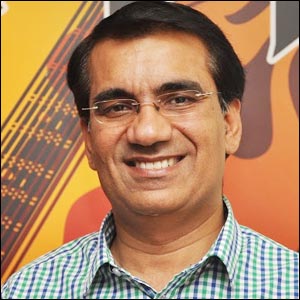 With an aim to grow the company 10 times by 2020, Dinesh Gulati, director, IndiaMART, is a restless man. Currently a discovery platform with 2.5 crore products, ranging from a pin to big machines, IndiaMART was founded in 1996. The platform has seen a sea change and now boasts of having 1.9 million suppliers and almost 1.5 crore unique monthly visitors (buyers). The B2B platform claims to generate eight million tracked business enquiries each month with a GMV (gross merchandise value) of $ 4-5 billion.
With an aim to grow the company 10 times by 2020, Dinesh Gulati, director, IndiaMART, is a restless man. Currently a discovery platform with 2.5 crore products, ranging from a pin to big machines, IndiaMART was founded in 1996. The platform has seen a sea change and now boasts of having 1.9 million suppliers and almost 1.5 crore unique monthly visitors (buyers). The B2B platform claims to generate eight million tracked business enquiries each month with a GMV (gross merchandise value) of $ 4-5 billion.
The brand has an annual marketing budget of Rs. 40-50 crore (which is roughly 12 per cent of the total turnover), of which almost 60 per cent is for TV, 25-30 per cent for digital and 10 per cent for outdoor.
Gulati and team have their eyes set on a turnover of Rs. 365 crore in 2016. “Our ‘Mission 2020’ is to become a 2000 crore company,” he declares.
Edited excerpts.
Q. You are one of the early movers in the e-commerce space. Tell us how the larger market has changed over the years and how IndiaMART adapted to these changes.
The market has evolved dramatically over the last five to seven years. In 2007-08, we were a marketplace for exporters who did not have online presence. We had their catalogues, generated business enquiries and sent them to exporters by fax. The categories we dealt with then were brass ware, apparels and handicrafts, among others. It was a very small segment.
We converted IndiaMART into a domestic marketplace in 2008, engaging with small and medium enterprises (SMEs) operating in the local markets. We started with one lakh SMEs which has now grown to approximately 1.9 million, which range from Rs. 5 lakh to 500 crore. We have 1.5 crore monthly visitors.
The biggest game changer has been internet penetration. It was not even 10-11 per cent till 2011; it now stands at close to 30 per cent. Mobile has aided in the increased internet user base and Facebook as well WhatsApp have further helped in the growth curve. Cash on delivery (COD) feature on B2C sites has also helped consumers to trust the online medium.
Q. That’s interesting…
These factors helped in changing the way SMEs looked at online medium. Having said that, there are a total of 4.5 crore SMEs and only 25 per cent of them are online. In China, SMEs have 78 per cent and in US 95 per cent of internet adoption.
For almost a decade, IndiaMART has been playing the role of an evangelist. We set up almost 70 offices, across the country, close to SME clusters like Surat, Baroda, Indore and Tiruppur, among others. Every industrial area has a service and sales office and the objective is to explain to them the concept of internet and how it can solve their problems. SMEs face three big challenges – access to the market, finance and technology. Three to four years back, about 70 per cent of our customers started their internet journey with us. They would first register for free, generate business and eventually become a paid customer.
Q. How crucial is the mobile medium for a B2B category player like IndiaMART?
Mobile has become a habit even for SMEs. In the mobile space, we are the only player in the B2B category to have invested in an app across platforms. We have crossed two million downloads in one year. But, we will never move to an app-only model because there will always be businesses which will be comfortable on desktops.
Our TG includes corporate houses where procurement or purchase managers access our platform through desktops. Mobile is becoming a conversion tool for us. Almost 57 per cent of our traffic comes from mobile.
Q. What’s your core TG?
Our core TG is corporates (purchase managers), businesses (small or big) and suppliers in the 25-45 age group. But, today, we are also able to handle individual requirements.
Q. After almost 10 years of operations, you launched your first TVC last year. How do you approach mass media?
Last year, we achieved a turnover of Rs. 200 crore and we felt it was time to invest in brand building. The campaign (titled ‘Kaam Yahin Banta Hai’) helped us create awareness, top-of-mind recall and business KPIs (key performance indicators). Our direct search went up by 25 per cent, business enquiries went up by 20-22 per cent and app downloads went up by 40 per cent. Besides, our credibility increased among SMEs.
Our spends have predominantly been on events, digital and direct mailing; a single medium does not give an ideal ROI. We have created properties like ground events where we engage with SMEs directly.
Through a business property called ‘Emerging Business Forum’ (executed in collaboration with Zee Business) that targets Tier II cities, we’ve reached out to 60, 000 SMEs in 40 cities.
In the last two to three years, we started spending on online sites relevant to our TG like Economic Times and Yahoo. We spend only 3-4 per cent on outdoor. We have never invested in print advertising because it is predominantly a B2C medium.
Read more at http://www.afaqs.com/interviews/index.html?id=475_We-will-never-move-to-an-app-only-model-Dinesh-Gulati-Indiamart

